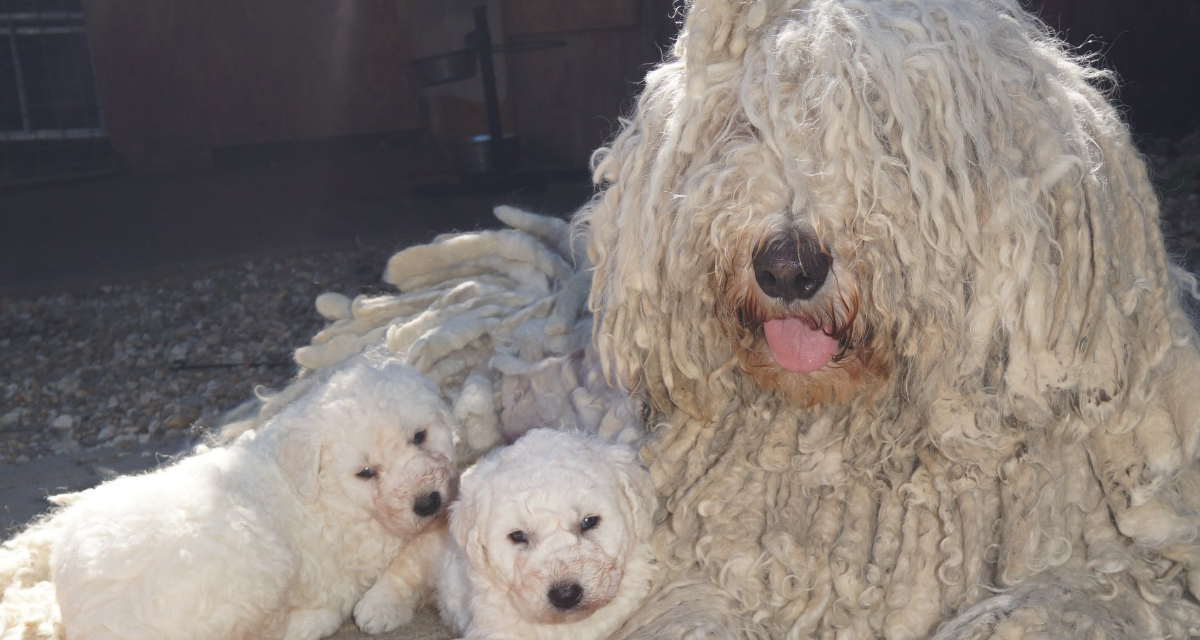Their numbers have dwindled, but they are flawless.
The Komondor is our dog's puppy. Hungarian. Not only because he has lived with us since ancient times, but also because deep down there is some psychological connection that basically connects us with him.
Every kennel has its own story. The komondor is not only special in appearance, but also has a disarmingly good and friendly nature, so it doesn't take minutes for a person to fall in love with it.
Roland Anda also did the same. He met a Komondor next door, and then…
A male, a certain Pasha, was the first komondor of the Anda-Marócsek family. He won competitions, everyone admired him. Roland and his wife, Anita, bought eye-catching bitches for him, the bred bloodline produced excellent dogs.
It is a particularly calm breed. Some could even be taken to the church mass, says Mrs. Anita.
Of course, it is quite easy to misunderstand this calmness. The Komondor loves children, gets along well with other animals and even other breeds of dogs, if we invite them into the apartment, they lie down on the carpet, do not jump on the table, do not knock anything over. Unlike kuvas, he doesn't just choose one owner for himself, he bonds with all members of the family, he even listens to the children. That's why they call him a family dog. At the same time, however, he is determined to protect the yard he was entrusted to guard. Its sluggishness is deceptive, because it is actually very flexible and lightning fast when the going gets tough. But not only because of his abilities, but also because of the thick fur that protects his body, he could never be an equal opponent to a wolf or other wild animal that attacked his territory.
The Komondor is not a fashion dog.
Ms. Anita even took a dog out to Heroes' Square in Budapest, let everyone admire it, let this uniquely Hungarian, ancient breed make a name for itself again. You can meet six Komondors in the family's yard in Czömör, but Ms. Anita has a total of thirty dogs. He placed the others with friends, acquaintances, and dog-crazy families, and visits them regularly. Of course, the puppies born in the kennel are also regularly sold, and he follows their fate as well.
If one listens to Anita Anda-Marócsek, it turns out that the komondor does not require special care.
He eats two or three rumps, plus about 20 grams of feed per day. From time to time, they also get beef scraps in their bowls, but if they get too much food at any time, they leave the excess.
Anyway, they eat strictly separately, one might say separately, this is also a sensitive point for komondors. By the way, the Komondor is a herding dog, and its body makes particularly good use of its food. Because of its fur, which is thought to be shaggy, many people dislike it from the start, even though there is nothing wrong with this fur. The komondor grows either felt or ribbon fur, and this needs to be taken care of from time to time, for example separating the strands when the animal is a puppy. That's it. And the clipping, which means that Mrs. Anita cuts the dogs' fur to about 25 centimeters. That way, they are well taken care of and move easily. It is also important that the fur of the breed does not cause allergic symptoms in anyone.
Ms. Anita appears from time to time not only in the field of Hősök, but also in kindergartens and schools, to popularize the breed.
The effect is huge. It is a fact, of course, that they are beautiful dogs, and in the home of the Anda-Marócsek family, you can't even count the cups and medals that their dogs have won at various exhibitions and competitions. When the animal is about one year old, it shows what kind of dog it will be as an adult, according to Ms. Anita, bitches are better now, one good-looking, strong male gets five very tight, eye-catching bitches.
- As with the Kuvasz, 220-270 puppies are born in this breed every year in Hungary, and there are approximately 2,000 registered Komondors in our country - sums up the situation, Attila Kovács, president of the Hungarian Komondor and Kuvasz Association.
It has been ten years since statistical data have stagnated at this level. Unfortunately, the breed is less and less sought after, at the same time the Russian, Serbian, and Caucasian shepherds were picked up by the media, but now interest in them has also waned.
Attila Kovács states that whoever keeps the komondor does it primarily out of dedication.
It is a persistent animal, a little different from the kuvas, at one time they tried to return it to its original, herding lifestyle, but unlike the kuvas, it was not possible to obtain state support or launch a large, comprehensive program. The Kuvasz lobbies were stronger and more persistent, that's all. What is important now is that we can keep the stock at least at today's level.
"There's nothing wrong with the Komondor," continued Attila Kovács, "even if he has become a typical family dog, not the flock, but the gatekeeper, the faithful guardian of the yard." Stupid, lazy, stunted, it was claimed at one time, but this is not even close to the truth. According to the tests, komondors are still characterized by healthy, diverse genetics and are not at risk of degradation.
In Tahitótfalu, the situation is a little different, as far as the return of dogs to their original function is concerned. In the kennel of Ágnes Lőrinczyné Velencei, the stranger can count six komondors, they also guard the garden and the yard, but they were also entrusted with the security of the family's farm, which is further away. At the Ágnes of Venence, you can see not only goblets and prizes, but also the colorful periodical Komondor Magazin and a maternity room. Bitches breed here, in this room, and puppies spend their first days here. This particular farm came into the family's possession for the first time, and the question immediately arose as to what kind of dog would fit there. The answer: komondor. Incidentally, Ágnes Velencei is the secretary of another organization, the Hungária Komondor Club. The club publishes the beautiful, colorful periodical Komondor Magazin.
In this kennel, the dogs mostly eat duck tails and breastbones, and Mrs. Ágnes also regularly cooks jelly for them to replace collagen.
The family's house stands in a very beautiful place, on the side of a mountain, on the other side of the fence there is already a forest, which is now regularly visited by wild boars. In other words, the territorial guard komondors are not bored. They do not have a destructive temper, rather they only strive to chase away the uninvited guest.
The family lives together with the dogs, who move comfortably inside the apartment. Their hair is cut shorter, 5-10 cm, by Ms. Ágnes, whose regular task is also to manage the shift.
That is, he takes one herd out to the farm and brings the other one in. In both trios, the issue of leadership is played out, and a dynamic balance has developed in the groups. The family keeps sheep, rabbits and lots of poultry on the farm, above all the area, but the dogs also protect the animals. They already know the sound and flight of its shell; when the bird of prey appears, the dogs run into the chickens and hens, so they don't dare to attack. The Komondors were given a separate small warming room, so in winter the straw is knee-deep in it, but the cats also have their own house here, with an armchair and a sofa.
The dogs are good friends with them, just as they never hurt the livestock. They do not need to be taught this, it is a "factory program" operating in their consciousness, just like the instinct of guarding. By the way, it is also typical of the breed that the dogs within the pack learn from each other.
The puppies of Ms. Ágens' kennel guard an alpaca farm in Germany, for example. In Spain, they work with horses, but they also work with animals in Finland. Some of them made their way beyond the sea, according to some reports, there are about two thousand registered Komondors in America, although there is a somewhat specific selection within the breed. The slightly smaller individuals are further bred.
Mrs. Anita also told us that komondors from her also went to Russia, in particularly cold conditions. They can handle it. Although their owners there have built huge, hall-like buildings for them, they still take them out for a one-hour walk even in minus fifty degrees. They are great dogs, everyone everywhere admits that.
Their fate is a metaphor for the fate of Hungarians. Their numbers have dwindled, but they are flawless. There are fewer of them, but they hold their own.
Cover image: The komondor is not a fashion dog
Source: Facebook/Anita Anda-Marócsek












